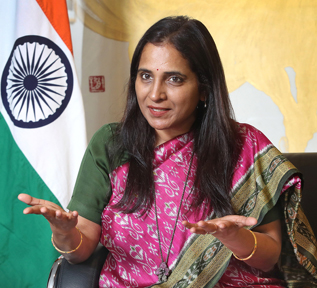WASHINGTON, D.C. (TIP): The relationship between the world’s two largest democracies, which have made significant progress in the last 20 years, now can be as ambitious as “we choose to be,” a top Indian diplomat has said. “When I look at the broader relationship, the India US strategic partnership, I think we have now reached a stage where we can say that the partnership has come into its own. We have achieved a lot over the past 70 years. But what we have achieved over the past 20 years has been at a different level altogether. And I would say that now we are at a stage where we can be as ambitious as we choose to be,” said India’s Deputy Ambassador to the US, Sripriya Ranganathan. The top Indian diplomat was speaking at the Stanford India Dialogue, the Leaders of Tomorrow Conference, organized by Stanford India Policy and Economics Club (SIPEC), in partnership with the Motwani Jadeja Foundation.
“We can decide to set our goals, set our sights on targets that were unimaginable a few years ago, and we can. Not only can we be ambitious, but we can also be confident that we can make these things work, we can bring to implementation ideas that would’ve seemed outlandish even 20 years ago,” Ranganathan said at the conference.
Standford Professor at its School of Medicine Dr Anurag Mairal, who has been instrumental in the conference, said this is the first India conference on the west coast of this size. The US-India partnership is going to be the most defining partnership of its kind for the next three decades, he said.
Citing the example of India-US relationship in the field of space and the area of emerging and critical technologies, Ranganathan said scientists and policy from both the countries are actively engaged because “we see these as being the frontiers of the future and what will allow us to gain the leadership role in the shape of the global economy” in the next few decades.
“We have reached the stage where we have been able to say to each other the let’s work together so that we are able to shape this world together, so that we are able to discover where the areas of overlap are, where are the areas of complementarity so that together we are able to make a difference. I think if we look back after about 10 years, we will find that there are at least 10 to 15 interesting, important and profound projects that India and the US have been able to work on and concretize so that we are able to make this fantastic platform of our collaboration,” Ranganathan said. The top Indian diplomat urged the students, in particular those from India and of Indian origin, of Stanford to stay connected with India. “I would urge you to maintain your connections with India and bring some of these learnings also back to India so that we are able to also benefit from the knowledge that you’re picking up over here,” she said.
“The second is a bridge of collaboration. If you can join hands both on campus and beyond with your friends, with your peers in the US, professors in the US, and be able to pursue excellence in partnership with them, I think that is an area of exploration that we feel would yield us tremendous dividends going forward,” she said.
“The third bridge is the bridge of culture. If you can in your conversations, in your interactions, share the cultural perspectives, share your stories, break down the stereotypes and spark off that interest in India. In knowing about India and experiencing India, sharing the amazing progress that India has made in the past few years with your colleagues and friends and fellow students here on campus, I think that would be an amazing contribution that you would be able to make,” Ranganathan said.
India’s Consul General in San Francisco K Srikar Reddy told the participating students of Stanford University, many of whom were of Indian origin or from India, that after gaining knowledge at this prestigious university, most of them will prosper not only here but also go back to India and become part of this overall Indian development.
India is expected to become a USD 7 trillion economy by 2030. Prime Minister Narendra Modi has given a call to all Indians living in India and abroad, especially the youth of the country, to make India a developed country by 2047, he said. “We are expecting India to be a USD 35 trillion economy by 2047. And we are also expecting India to overtake the US economy in 2060. It means you’ll be seeing India as a big, developed country and each one of you are going to become partners in India’s economic growth,” he said.
Emphasizing student-centeredness, the conference was marked by candid discussions wherein speakers gave their honest opinions about India’s growth story, the development of the US-India partnership, and, most importantly, what students can do to become a part of these exciting advancements.
Indian-American venture capitalist Asha Jadeja Motwani said the Indian diaspora is now five million strong. “It is also the highest income diaspora, as far as the US system goes. (This is) our second motherland, which has given us so much, and we are contributing back in terms of we are two per cent of the population, but we are six per cent US taxes now. So, the Indian diaspora is doing extremely well in the US,” she said. “What is its impact in the US? Again, it’s massive, especially in two fields. One is in IT in technology as in Silicon Valley, we are a huge influence here in terms of innovation. My late husband, Rajiv Motwani, who was a professor at Stanford University, was instrumental in creating the Google algorithms and in the creation of Google as a company,” she said.
